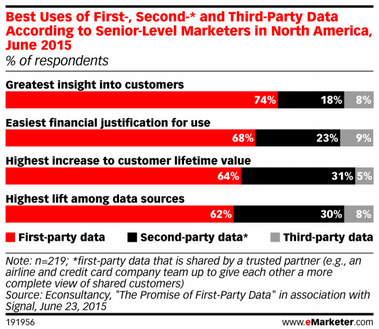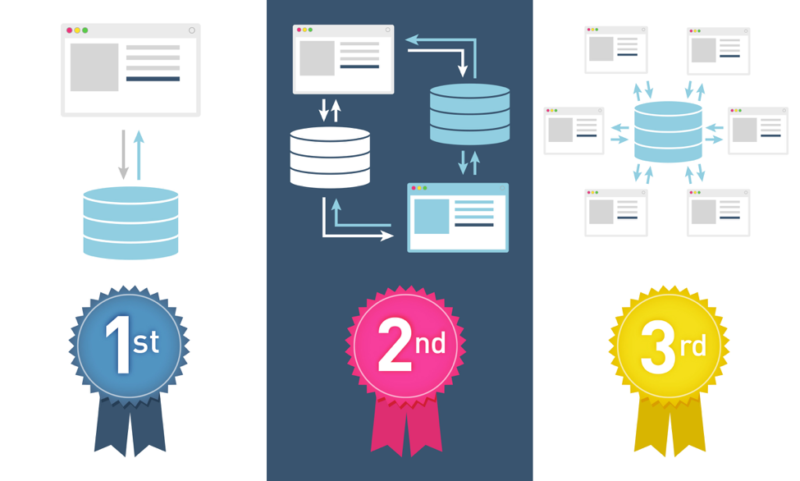Using Second-Party Data To Expand Reach & Improve Your Retargeting
Second-party data can be extremely valuable to marketers, yet it's not as well understood or as widely employed as first- or third-party data. To help clear the fog, columnist Matt Ackley explains second-party data and its uses.
We already know the importance of first– and third-party data. We’ve tossed in this concept of second-party data every now and again, but without much in the way of concrete examples and recommendations on how to use it.
Despite that, there was an interesting nugget in a June 2015 eMarketer report, “Marketers Put First-Party Data First,” which found that senior-level marketers find significantly more value in second-party data than they do with third-party data.
However, in our experience, we run into many more clients who use third-party data than those who use second-party data. Why is that the case? In contrast to first- and third-party data, it’s not always clear in what scenarios second-party data is useful, and what the best methods to find and use that data are.
Defining Second-Party Data
Before getting into some of the ways to use second-party data, let’s take a moment to define it.
Second-party data is another company’s first-party data that’s made directly available for other companies to use. This data can be made available through direct partnerships, data management platforms, or a second-party data network.
Four Things You Might Not Have Known About Second-Party Data
- It’s more reliable than third-party data. The reliability of third-party data can vary significantly depending on where the data comes from and how recent it is. Unfortunately, you generally won’t know how reliable it is until you’ve bought it and tested it. In contrast, because second-party data is another company’s first-party data that you have direct access to, there’s more assurance that the data is recent and from a high quality source.
- Second-party data’s scarcity increases its competitive value. Acquiring second-party data isn’t as easy as acquiring first- or third-party data. While advertisers can access second-party data through data exchanges or Data Management Platforms, second-party data just isn’t as ubiquitous as third-party data. However, this lack of liquidity creates a unique competitive advantage for companies who can acquire second-party data at scale and intelligently use it to enhance their marketing campaigns.
- Second-party data helps advertisers find new audiences. Second-party data allows you to expand your reach by targeting audiences who are more likely to show interest or share some qualities to your own customer base. The important thing to keep in mind here is that with second-party data, you’re reaching new audiences. So, the performance baseline should be other prospecting campaigns.
- Second-party data can also help improve performance of retargeting campaigns. We know second-party data can help you find new audiences that should be more relevant and qualified. But how much more relevant and qualified is that audience?
We looked back at the display retargeting data we capture through the Marin Global Digital Advertising Index and found that when advertisers started prospecting with second-party data, it also had the effect of improving their retargeting campaign performance.
We looked at a sample of large display advertisers and their retargeting performance for three months prior to starting prospecting campaigns utilizing second-party data. Then we compared this against their retargeting performance for three months after prospecting with second-party data.
For these advertisers, we found increased engagement and efficiency. The average click-through rate increased by over 23%, while view-through conversions increased by over 14%. Meanwhile, advertiser efficiency also improved, with CPMs dropping by nearly 6% and CPA dropping by over 30%.
These benchmark figures demonstrate the potential that second-party data can have for any performance-oriented display advertiser. Just like mixing different types of investments can help you improve performance while reducing risk, adding second-party prospecting into the marketing mix can help you expand your audience base — while improving overall return.
Best Practices For Using Second-Party Data To Your Advantage
- Better partners lead to better results. As the saying goes, garbage in, garbage out. Second-party data isn’t any different. Your success depends on finding the right partners and sources of data. Ideally, the second-party partner should have a unique, but relevant audience. For example, an airline may exchange data with a car rental company. These two companies, while not directly competing, have audiences that are related and may overlap. By sharing relevant data between the two companies, both may benefit through unique insights and additional audiences to target and serve ads to.
- Use the right tools. It’s not always clear where to find second-party data. Second-party data exchanges like Marin Software’s Partner Connect can simplify the process of finding and onboarding partners. Data Management Platforms, which collect, link, and share publisher data with advertisers, are also useful tools to help leverage second-party data.
- Make use of shared data to better understand your audiences. Generally, we find that our clients use second-party data most often to look for new customers. However, there is obviously going to be some overlap between a partner’s data and your data. These overlapping areas can contain valuable insights that enrich and enhance your own first-party data for stronger and more specific targeting.
- Mitigate privacy and security concerns by using non-personally identifiable information. Consumer privacy and data security are two of the biggest concerns when sharing second-party data. Ultimately, it’s up to each individual company to determine what data they’re comfortable sharing. However, the potential risks can be mitigated by using a platform that doesn’t capture personally identifiable information to begin with.
Conclusions
Second-party data offers the dual benefit of allowing advertisers to reach and target new audiences, while also making your first-party campaigns more focused and efficient. With the right partners and the right tools, there’s a wide-open world for gaining unique data about your audience and continuing to improve your value proposition.
Contributing authors are invited to create content for MarTech and are chosen for their expertise and contribution to the martech community. Our contributors work under the oversight of the editorial staff and contributions are checked for quality and relevance to our readers. The opinions they express are their own.
Related stories
New on MarTech



